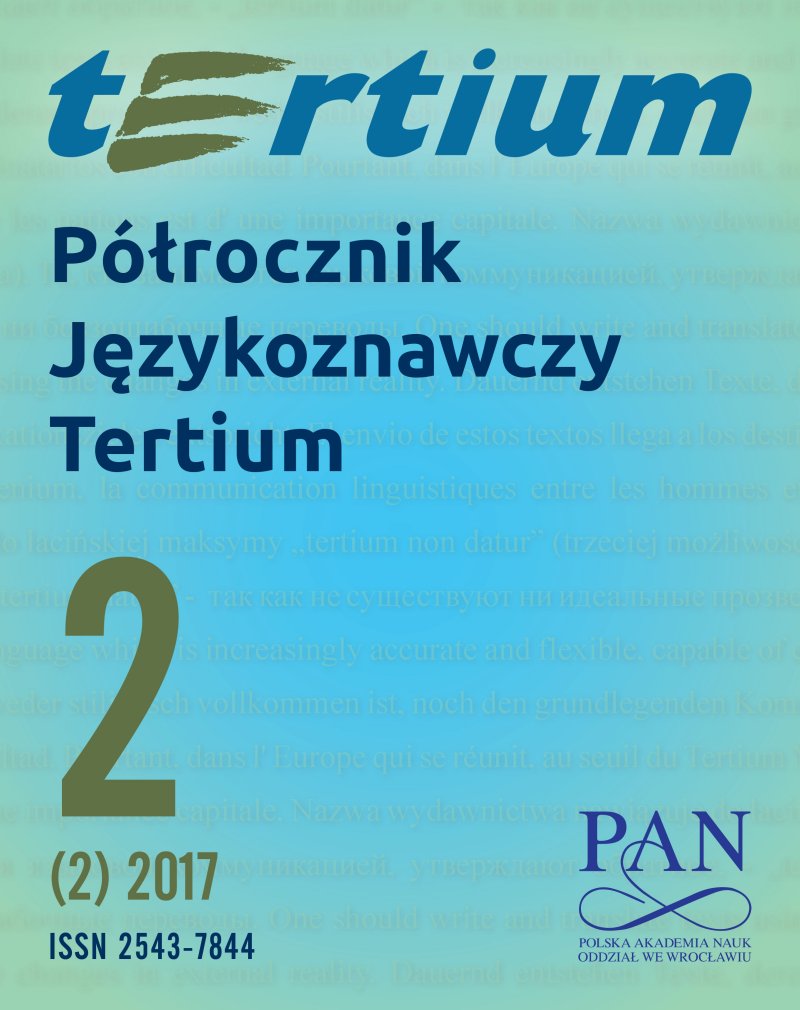Abstrakt
The study looks at how the fear of the Other, rampant in contemporary societies, is countered linguistically in selected English-language discourses, including both sides of the Atlantic, Australia, and New Zealand. The overarching conceptual category of THE OTHER is internally heterogeneous and involves linguistic portrayals through such terms as other, different, foreigner, stranger, or alien. The kinds of discourses that will be analysed, i.e. those aimed to reduce the level of the fear of or the hostility towards Others, contextualize these terms in ways markedly different from those in the fear-augmenting discourses. Typical devices used for the purpose are collocations and lexical patterns within the text.
The data come from British, American, Canadian, Australian, and New Zealand press and public discourse, with some insight also obtained from Ryszard Kapuściński’s book The Other. However, because the book is a series of lectures translated from Polish into English, a brief excursus into the analogous portrayal in the Polish original is also performed. On the theoretical side, the analysis will hopefully provide a hint as to whether and in what ways the heterogeneity of THE OTHER as a concept can be captured in terms of differential cultural models.Bibliografia
Bartmiński, Jerzy (2009) Aspects of Cognitive Ethnolinguistics. London and Oakville, CT: Equinox.
Bartmiński, Jerzy (2013) “The Cognitive Definition as a Text of Culture.” [In:] Adam Głaz, David S. Danaher, Przemysław Łozowski (eds.), The Linguistic Worldview. Ethnolinguistics, Cognition, and Culture. London: Versita, 161–180. [open access: www.degruyter.com/view/product/246955]
Bennardo, Giovanni, Victor C. de Munck (2014) Cultural Models: Genesis, Methods, and Experiences. New York: Oxford University Press.
Costa dos Santos Benedito, Fernanda (2017) “The Representation(s) of ‘The Other’ in Passage to India by David Lean.” Journal of Literature and Art Studies, 7 (2); 179–185. doi: 10.17265/2159-5836/2017.02.005
D’Andrade, Roy G. (1989) “Cultural Cognition.” [In:] Michael I. Posner (ed.), Foundations of Cognitive Science. Cambridge, Mass.: MIT Press; 795–830.
Everett, Daniel L. (2008) Don’t Sleep, There are Snakes. Life and Language in the Amazonian Jungle. New York: Vintage Departures.
Głaz, A. (forthcoming) “Analogy in Action: From Space-time to Differential Cultural Models.” [In:] Barbara Lewandowska-Tomaszczyk, Marcin Grygiel (eds.), Contrast and Analogy in Language: Perspectives from Cognitive Linguistics. Amsterdam/Philadelphia: John Benjamins.
Goddard, Cliff, Anna Wierzbicka (2014) Words and Meanings: Lexical Semantics Across Domains, Languages, and Cultures. Oxford: Oxford University Press.
Hegel, Goeorg Wilhelm Friedrich (1807) Phänomenologie des Geistes. Bamberg und Würzburg: Joseph Anton Goebhardt.
Husserl, Edmund (1931) Meditations Cartesiennes: Introduction à la phenomenologie. Trans. G. Peiffer and E. Lévinas. Paris: Armand Collin.
Hutchins, Edwin (1995) Cognition in the Wild. Cambridge, Mass.: The MIT Press.
Kapuściński, Ryszard (2009) The Other. Trans. A. Lloyd-Jones. London and New York: Verso.
Kristiansen, Gitte, René Dirven (2008) “Introduction. Cognitive Sociolinguisitcs: Rationale, Methods and Scope.” [In:] Gitte Kristiansen, René Dirven (eds.), Cognitive Sociolinguistics: Language Variation, Cultural Models, Social Systems. Berlin and New York: Mouton de Gruyter; 1–17.
Kronenfeld, David (2018) Culture as a System: How We Know the Meaning ond Significance of What We Do and Say. London: Routledge.
Lacan, Jacques (1997) The Seminar. Book III. The Psychoses, 1955-1956. Trans. R. Grigg. New York: W. W. Norton & Company.
Langacker, Ronald W. (1987) Foundations of Cognitive Grammar. Vol. 1. Theoretical Prerequisites. Stanford, CA: Stanford University Press.
Langacker, Ronald W. (2008) Cognitive Grammar: A Basic Introduction. Oxford: Oxford University Press.
Lévinas, Emmanuel (1961) Totalité et Infini: Essai sur l'extériorité. La Haye: Martinus Nijhoff.
Lévinas, Emmanuel (1974) Autrement qu'être ou au-delà de l'essence. La Haye: Martinus Nijhoff.
Nail. Thomas (2015) The Figure of the Migrant. Stanford, CA: Stanford University Press.
Sartre, Jean-Paul (1943) L'Être et le néant: Essai d'ontologie phénoménologique. Paris: Gallimard.
Sharifian, Farzad (ed.) (2017b) Advances in Cultural Linguistics. Singapore: Springer.
Sharifian, Farzad (2017a) Cultural Linguistics. Amsterdam/Philadelphia: John Benjamins.
Shore, Brad (2012) “Egocentric and Allocentric Perspectives in Cultural Models.” [In:] Ron Sun (ed.), Grounding Social Sciences in Cognitive Sciences. Cambridge, MA: MIT Press; 89–123.
Underhill, James W. (2009) Humboldt, Wordview, and Language. Edinburgh: Edinburgh University Press.
Underhill, James W. (2011) Creating Worldviews: Metaphor, Ideology and Language. Edinburgh: Edinburgh University Press.
Wierzbicka, Anna (1996) Semantics: Primes and Universals. Oxford: Oxford University Press.
Wyrwa, Anna (2017) “Personal World and Valuation in Interlingual Debate.” [In :] Joanna Ziobro-Strzępek, Władysław Chłopicki (eds.), Across Borders 6. The West Looks East. Krosno: Państwowa Wyższa Szkoła Zawodowa im Stanisława Pigonia; 59–73.
Licencja Uznanie Autorstwa- Użycie niekomercyjne-Bez utworów zależnych (CC BY-NC-ND). Autorzy zachowują prawa autorskie do swoich publikacji.

